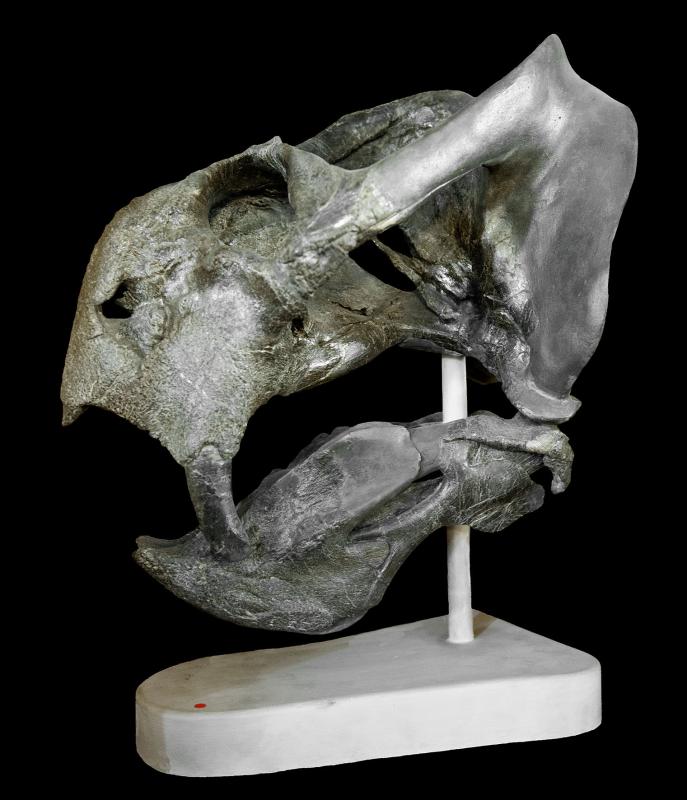Selective extinction events, rather than evolutionary novelties, may be the key factor responsible for determining the dominant land vertebrates, according to a new study published in Scientific Reports by researchers at the Museum für Naturkunde in Berlin and the University of Lincoln, UK.
The concept of adaptive radiation is central to modern evolutionary biology. An adaptive radiation is an extremely rapid increase in the number of species in a group, often as a result of a key evolutionary innovation, which gives the group an advantage over its competitors or allows it to exploit a new resource. Often, if the appearance of an evolutionary novelty coincides temporally with a large increase in species richness, it is assumed that the innovation is responsible for this pattern.
The new study examined the issue of adaptive radiations among early land vertebrates, from 315 to 200 million years ago. This time period witnessed some of the most profound climate changes on a global scale, including the dramatic shrinking of the southern polar icecap, the disappearance of equatorial rainforests, a substantial increase in temperature, and prolonged drought conditions. The time period under study also included the largest mass extinction in Earth’s history, about 252 million years ago.
The scientists used statistical methods to identify which of the vertebrate groups present during this time were significantly more diverse than their close relatives, and attempted to identify the factors responsible for this diversity imbalance. The results suggest that usually large differences in diversity between two closely related groups are not because more species evolve in the larger group, but rather because more species of the smaller group go extinct. More peculiarly, even the appearance of a key innovation in the larger group does not promote a higher number of species until a new major extinction takes place.
The scientists point to the example of dicynodont therapsids, a group of extinct plant-eaters closely related to mammals. About 270 million years ago, dicynodonts evolved a toothless beak and a fore-aft motion of the lower jaw, all of which are clear functional adaptations to efficient processing of plant material. However, it was not until 10 million years later, during a minor extinction event, that dicynodonts began to outcompete their close relatives and became hugely diverse. A similar pattern is seen in sauropodomorph dinosaurs, the group which would go on to produce the largest land vertebrates of all times, such as the celebrated Brachiosaurus housed at the Museum für Naturkunde Berlin. The large-bodied members of this group do end up becoming significantly more diverse than their close relatives, but not until a mass extinction event that took place at the end of the Triassic, almost 30 million years after their first appearance.
“It appears that these ‘key innovations’ do not promote massive increases in species richness, but instead buffer against extinction when times get tough”, said lead author Dr Neil Brocklehurst, a current postdoc at the Museum für Naturkunde Berlin. Co-author Jörg Fröbisch, Professor for Palaeobiology and Evolution at the Museum für Naturkunde and Humboldt-Universität zu Berlin, added: “Surprisingly, when these early terrestrial vertebrates evolved a novel structure or function, they did not undergo a dramatic increase in species number. Instead, an adaptive radiation usually occurs much later in the history of these groups, during one of the many extinction events or during times of climate stress”. Johannes Müller, Professor of Palaeozoology at the Museum für Naturkunde and Humboldt-Universität zu Berlin, said: “We really did not expect any of these patterns. Our results go against many of the traditional predictions from evolutionary biology, and show that the scientific views about the relevance of key innovations should be carefully reconsidered.” Dr Marcello Ruta, from the University of Lincoln, concluded: “Using large-scale evolutionary trees for various groups of organisms, it is possible to address major evolutionary questions that Charles Darwin, and many generations of biologists after him, asked: How did Life become so diverse? What triggers major diversification events? How do animals and plants respond to global catastrophes? We anticipate many exciting developments in these areas over the next decade.”
This research was sponsored by a Sofja Kovalevskaja Award of the Alexander von Humboldt Foundation.
Publication:
Brocklehurst et al. (2015) Elevated Extinction Rates as a Trigger for Diversification Rate Shifts: Early Amniotes as a Case Study. Scientific Reports 5:17104 DOI: 10.1038/srep17104
Free pictures for publication you can find here:
download.naturkundemuseum-berlin.de/presse/Dicynodontier
Credit:
1. Dinosaur hall with Brachiosaurus brancai, Museums für Naturkunde Berlin (Photographer: Antje Dittmann, MfN Berlin)
2. Dicynodont skull, an extinct plant-eater (Photographer: Hwaja Götz, MfN Berlin)
Contact:
Dr. Neil Brocklehurst, Tel: +49(0)30 2093 8306, E-mail: neil.brocklehurst@mfn-berlin.de
Prof. Dr. Jörg Fröbisch, Tel: +49(0)30 2093 8941, E-mail: joerg.froebisch@mfn-berlin.de
Prof. Dr. Johannes Müller, Tel: +49(0)30 2093 8805, E-mail: johannes.mueller@mfn-berlin.de
